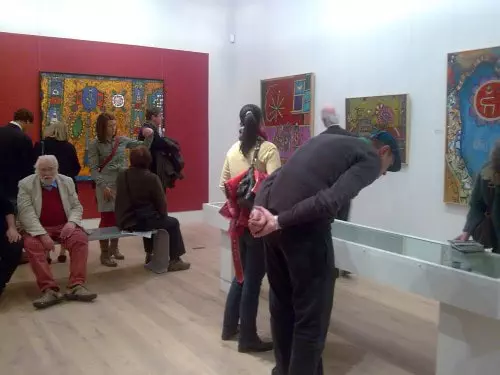
We asked Elly Snare to pound the streets of Leeds on our behalf, covering many miles and a fair few gallaries. This is a regular art walk, (every first Wednesday of the month) anyone can join, it’s free and you get to hear from the directly mouths of those that know their stuff. Anyway here’s Elly…
Art Walk 2 June 2010
Having always intended to take part on the Leeds Art Walk, but always failing for various boring and tedious reasons, writing a review of it for Culture Vulture finally meant I was forced to attend, much like a school trip. Like a school trip, the Art Walk involves much traipsing around the city and visiting cultural milestones, but with the added benefits of being educative while remaining interesting.
Starting at the Stanley and Audrey Burton Gallery in the Parkinson Building at Leeds University, we were talked extensively through their new exhibition of a small retrospective of Alan Davie’s work. His work, painted explosions of colour, symbolism and texture, are grouped into a small area of the gallery, creating an intense space to absorb the work’s improvisational, excitable qualities. Tying in ideas of jazz improvisation, cross-cultural symbols, ‘free’ painting and decorative arts, the retrospective gives an idea of the innovative path he has taken in his career. From the early, dynamic works, Davie then establishes a visual language that remains spontaneous but starts to resemble snapshots, frozen mural-like passages of time and space rendered in vivid colour and intricate detail.
From there we were herded over to Leeds College of Art and Design for a succession of, while interesting, slightly disappointing exhibitions. The video art of the Duvet Brothers, entitled Blue Monday and set to the same anthemic tune, was placed unfortunately in the college canteen, but exuded some of the fear felt at the time of its execution – the 1980s – in its smattered, cut-and-pasted footage, offsetting the police violence against miners with the rise of Soviet Russia. And as Maggie’s face loomed across the screen, cutting to wastelands and missiles, one couldn’t help but hear slight, dangerous echoes of the current political climate reflected in the screen.
Tutor Adam Stone’s etchings and pin hole photography from his time on the Fourth Plinth was cramped into a corridor, not the first time I have had to queue to see some art. In the end, the most interesting pieces were those with double exposures or contrasts of light, with a negative Nelson’s Column extending like the Bat Signal into the black sky of London. Continuing the 1980s theme, downstairs at the College yielded a beautiful selection of Kevin Cummins’ photography of Joy Division. Poignant, striking and more than just ‘band shots’, these images will be recognisable as some of the most iconic ever released, including a portrait of Ian Curtis that would make any indie-kid-throwback melt.
The final stop in the College was a small exhibition of the collection of artists’ books housed at the Vernon Street campus, selected because they were not books. Included were aerosal spray cans, playing cards, indexed folders, kits and creased albums. Although very varied, and a personal interest of mine, I felt the exhibition lacked reference: no explanation was made as to why these works were artists’ books. Whether it was text, the use of a book somewhere – like the distilled (literally) book in a giant cider jar – or the use of paper ephemera, this exhibition needs something to explain itself. A book, perhaps?
After we left, luckily grabbing some sun, we eventually ended up at Leeds Art Gallery to view the exhibition of Sean Scully’s 1980s work. Yet again, the excellent curator was able to discuss pretty much everything about the work, and everyone – well, not everyone, ahem – listened attentively. After previously seeing Scully’s work at the opening talk, where they were flatly projected across the wall, the pure scale and voluminous nature of these paintings-sculptures was breathtaking. The colour and geometric qualities of details in his pieces, like fine cracks normally only seen between floorboards, are blown up to a larger-than-human scale. The main room, revelling in bright colour and muted dark shades placed next to each other, while enjoyable, was outshone by the real gem of the exhibition, his paper works. The delicate watercolours and textured charcoals that sparked connections between tiny paper scrap and huge wooden painting showed some of ‘pure’ elements of the first creative idea. ‘Study for Adoration’, 1982, seemed to sum up Scully’s aims in painting most succintly: strong colour, clear delineation, and a playful geometry that was somewhere rooted in the external world.
From there, we went next door for the opening of the new Hermann Obrist exhibition at the Henry Moore Institute. There’s a slight problem with my review here: we were a little tired by this point and there was a free bar (boxed rosé, anyone?). A quick whizz round the Obrist exhibition explained two things: yes, it is good and no, I did not give it the attention it deserved.
I found the Art Walk to be an excellent starting point for learning about new exhibitions in Leeds: those individuals who showed us round were well-versed and passionate about their subjects. Highly recommended for a bit of physical and cultural exercise.
Thanks for the review Elly, really glad you enjoyed the walk. For anyone interested the next Leeds Art Walk will take place on July 7 with the following schedule:
5.30 pm – Stanley & Audrey Burton Gallery: All Over the Place: Drawing Place, Drawing Space
6.15 pm – Henry Moore Institute: Drawings from the HMI archive
7.00 pm – Project Space Leeds: The Drawing Shed and Jerwood Painters
No need to book (though it does help us estimate numbers!) For more info contact [email protected] or 0113 242 5100